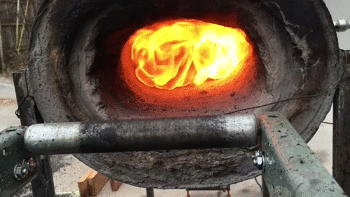2/24/2016
As fire has shaped the prairie, it must also shape the materials of our project.

The prairie is a deceptively tough environment, lacking shelter from the wind and sun. But as tough as surviving exposure to those elements is, it pales in comparison to the prairie’s most dominant force, fire. Fire defines the prairie, pruning the tallgrasses back to their roots while weeding out non-native inhabitants both natural and man made. Fire must drive both the aesthetics and performance of the materials of the project.
Finding a material which simultaneously provides an organic site specific aesthetic while incorporating the resilience needed to survive the prairie is a challenge. Even more challenging is a situation where it will likely go without maintenance for its long life span. Only a select few materials are able to meet these requirements: limestone; the foundation of the prairie, steel; the efficient structure, and charred cedar; a material directly shaped by fire.
Photo courtesy of Chris Helzer of ThePrairieEcologist.com

Example cross section of charred cedar showing protective char layer
Wood charring is not a new process, rather it’s a proven technology dating back to 1700s Japan. The Japanese noticed that after forest fires some trees would be left standing. It was discovered that a thin, even layer of char on the surface of the wood prevented the interior wood from burning. They applied this knowledge, known as shou sugi ban (burnt cedar), to their buildings in fire prone areas providing fire protection for generations.
Recently the technology has been rediscovered by architects looking to provide an environmentally conscious cladding that could stand up to tough environments. One such firm is Modus Studio in Fayetteville, Arkansas where we journeyed to learn more about the process. It was here that we learned of the necessity of getting even char penetration, without which the process becomes little more than an aesthetic choice. To accomplish this Modus built an automated forge utilizing a feed system which carefully controls the rate at which the boards are fed through the refractory.

The intense heat of the forge removes moisture from the perimeter of the wood, expelling it as steam, creating a surface layer of char. Immediately after the boards leave the refractory they are quenched with a spray of water insuring that the char ceases to permeate the wood guaranteeing absolute uniformity. The process of charring, rather paradoxically, provides unmatched protection not only from fire but also pests, rot, and weathering.
Cedar was chosen to char not only for its physical characteristics and relative cost effectiveness, but also because of its relationship with the prairie. Eastern Red Cedar trees are native, but invasive, to the prairie region. The material can be sourced locally which, in turn, improves the ecological balance by removing cedar trees. This sounds counterintuitive, but trees are the weeds of the prairie, commonly reducing local biodiversity by up to 90%. Additionally, cedar trees are far less efficient at carbon sequestration than prairie grasses. By turning cedar trees into a resilient building material we have created a rare tripartite tour de force by combining local sourcing, ecological improvement, and cost effectiveness. This makes it truly a material of and for the prairie.

Finishes for the charred cedar are integral to both the aesthetics and performance of the wood. One of the few drawbacks of charred cedar is that, when it is left unfinished, it sheds its loose ash covered exterior. This concerned our client, as the freshly charred platforms could get campers even dirtier than a jaunt through the prairie already would. Our prototyping team undertook an investigation of various finishes to learn their qualities. Pictured above is a prototype of the station platforms featuring two different varnishes. On the left is a matte interior finish, which gives a surface finish nearly indistinguishable from unfinished charred wood. On the bottom right is a semi-gloss outdoor finish which may have a longer lifespan. The prototype is currently being tested outdoors in order to evaluate the effects of weathering on the surfaces. After a week outside the prototype will be subjected to a literal trial by fire, proving the fire resistance of all materials and finishes involved.
Ultimately, these finishes are temporary, a stop-gap measure to delay the inevitable weathering which will take place. Instead of trying to prevent this natural evolution of the material, we are merely trying to control it. The varnish will slow the rate at which the ash is removed from the surface, distributing the process over a longer time scale and hopefully reducing the inherent “messiness” in the process.
Finish testing in the prairie

By using charred cedar as the primary material throughout the project we achieve an especially important goal. The material blends into the prairie, not only during the months in which it’s covered in waves of tallgrasses, but also in the alien landscape created by the spring burning. The deep iridescent black char of the cedar coalesces into the vast expanse of scorched earth in a way that no other material could possibly match.
Initial platform prototype

Written by Blake Toews
